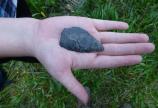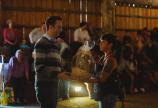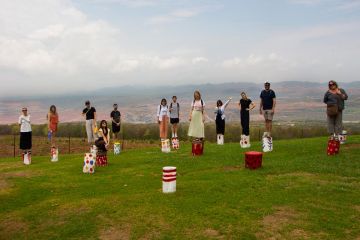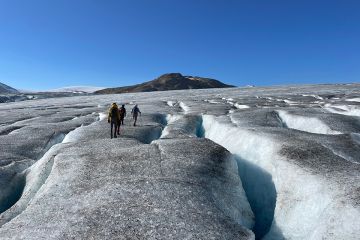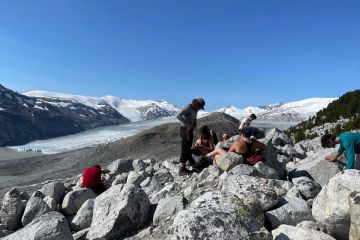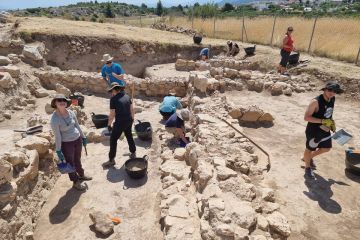Unique ethnohistory field school well into its second decade
- Tara Sharpe

The only ethnohistory field school in Canada to offer a firsthand learning opportunity involving traditional knowledges of oral history and research of historical documents has been immersing graduate students every second spring since 1998 deep within the Stó:lō community in BC.
Stó:lō Ethnohistory Field School
Stó:lō traditional territory extends from Yale to Langley. The area now called the Fraser River Valley and Fraser River Canyon was home to the Stó:lō people thousands of years before the 19th-century explorer Simon Fraser first followed the river’s course to its mouth.
“Stó:lō” is the Halq'eméylem word for this river; it thus means “the river people.” Place names are integral to the teachings of long-time educator, historian, treaty director and cultural advisor Naxaxalhts'i (whose European name is Dr. Albert “Sonny” McHalsie, the holder of a UVic Honorary Doctor of Laws). He points out many Stó:lō community members “don’t speak the language, but we still go out and use the land and end up using the English names.”
During each field school, Naxaxalhts'i takes students in his boat on interpretive trips of the river and ashore—with original place names dropping like stones into water with a ripple effect reaching well beyond the four-week course.
“It changes their whole perspective,” he says. “The land becomes alive. The meaning and significance of our place names, that is the part I hope to implant into them.”
“The course is transformative,” adds John Lutz, chair of the UVic history department. “Students see the practical value of applying scholarship to people’s lives. Learning firsthand about the sensitivities and issues behind the history of settler Canadians and First Nations is also very transformative.”
A four-week transformative experience
The field school is a collaboration between the Stó:lō Research and Resource Management Centre (SRRMC) and the history departments at UVic and the University of Saskatchewan, along with the Stó:lō Nation and Stó:lō Tribal Council. Students board for one week with Stó:lō families and then reside for three weeks in a traditional cedar longhouse. Cultural orientation activities (including place-name tours and protocol guidance, as well as attendance at spiritual and healing ceremonies) are facilitated by Stó:lō community representatives.
Under the direction of Stó:lō knowledge keepers, as well as Lutz and co-teacher Keith Carlson (USask), students then undertake individual projects interpreting complex historical issues identified by the Stó:lō community as having important contemporary significance. Previous topics include: identity, politics and Stó:lō ancestral names; routes of access to Stó:lō fishing sites; metaphysical tunnels in Stó:lō spiritual geography; and the lives and biographies of Elders.
The urgency of time passing is reflected in the gravity and richness of this last topic. “We have a list of various Elders and political leaders, but we do not have the funds to hire researchers,” explains Naxaxalhts'i. “But we still need it to be done.”
Bridging university and community
Naxaxalhts'i also looks ahead to the benefits of mobile apps and technology on historical and cultural place marking. MA student Sabina Trimble (history) attended the May 2015 field school and chose precisely this topic for her field-school research paper.
Digital mapping for the Stó:lō is now the focus of her master’s thesis. Final research papers are submitted at the end of summer to the Stó:lō Nation Archives. The papers are also posted on the field school website.
Trimble describes “the relationship and community building [as having] the most lasting effect” on her.
She also found that the enthusiasm in which the results of her paper were received when she returned to the community “reconfirmed the value of it and the very fruitful work in bridging university and communities.”
During the final week of the field school, the students host a potlatch feast where they formally thank all community members who assisted throughout the month-long program by presenting them with gifts.
The woven cedar hat presented to Lutz at the end of the most recent field school claims pride of place on a prominent shelf in his UVic office.
Naxaxalhts'i keeps a photo taken of himself on Pitt Lake by a former field-school student. She is caught in the reflection of his sunglasses, as is the lake behind her.
In Stó:lō tradition, one must not look into the water for fear and respect of the super-natural stlalaqum inhabiting the lake.
Naxaxalhts'i jovially points out it is her reflection that can be seen in the mirrored surface of his glasses.
‒ ‒ ‒
Read more:
Photos
In this story
Keywords: field schools, community, student life, graduate research, research, history, Indigenous knowledge, Indigenous, Elders
People: John Lutz



